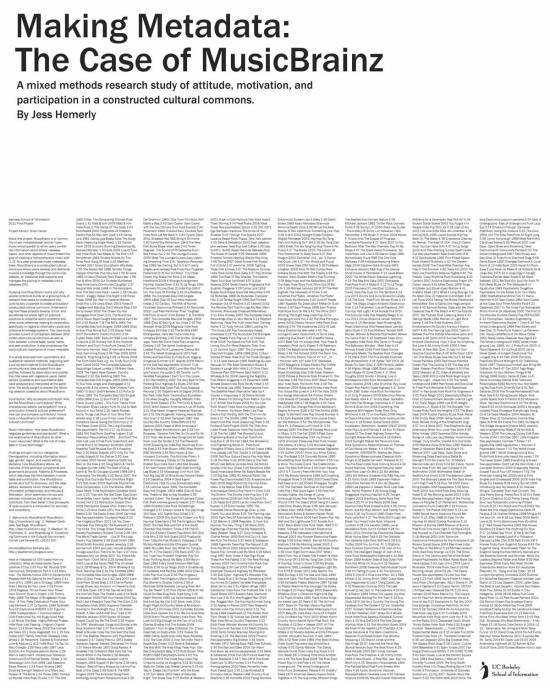Making Metadata: The Case of MusicBrainz
MusicBrainz is a “community music metadatabase” and an “open music encyclopedia” to which users contribute information about artists, releases, tracks, and other aspects of music toward the goal of creating a “comprehensive music site” [1,2]. As a peer-produced music metadatabase, MusicBrainz is a constructed cultural commons where users develop and distribute musical knowledge through the community website, an institution that supports and manages the pooling of metadata into a database [3].
Studying how MusicBrainz works and why people contribute builds on a growing body of research that seeks to understand how contributors cooperate to create and sustain constructed cultural commons. Understanding how these projects develop, thrive, and sometimes fail sheds light on potential solutions to collective action problems and other social dilemmas relating to cooperation, specifically in regard to information pools and collective knowledge systems. This case study provides a point of comparison between other constructed cultural commons as well as links between cultural taste, social habits, and peer-production. It also emphasizes the socio-cultural importance of music metadata.
This study employed both quantitative and qualitative research methods, beginning with a survey administered to the MusicBrainz community and data scraped from user profiles, followed by observation and qualitative interviews with registered users, called editors. Qualitative and quantitative data were analyzed and interpreted at the same time. The study sought to answer the following research questions about MusicBrainz:
- Contribution: Why do people contribute? Who are the MusicBrainz contributors? What characterizes editors’ participation? How is contribution linked to cultural preference? How can one compare contributors’ motivations in MusicBrainz to other constructed cultural commons?
- Music Information: How does MusicBrainz negotiate guidelines and standards? What is the relationship of MusicBrainz to other music resources? What is the role of metadata in music technology?
Findings are split into four categories: Demographics, including information about age, gender, region, and overall editing statistics; How MusicBrainz Works, an overview of the technical components and governance structure; Patterns & Processes, which describes the links between musical taste and contribution, how MusicBrainz serves as a tool for discovery, and the ways editors’ decisions mimic those made by information professionals; and Attitude & Motivation, which examines intrinsic and extrinsic motivations that drive users to contribute, from their belief in the philosophy of open source to a compulsion for accuracy and consistency.
[1] Welcome to MusicBrainz! MusicBrainz. http://musicbrainz.org/.
[2] Release Candidate Test Page. MusicBrainz. http://test.musicbrainz.org/.
[3] Madison, M., Frishmann, B., and Strandburg, K. Constructing Commons in the Cultural Environment. Cornell Law Review 95, (2010), 657.










